We put the Google Pixel 7 Pro through our rigorous DXOMARK Camera test suite to measure its performance in photo, video, and zoom quality from an end-user perspective. This article breaks down how the device fared in a variety of tests and several common use cases and is intended to highlight the most important results of our testing with an extract of the captured data.
Overview
Key camera specifications:
- Primary: 50 MP 1/1.31-inch sensor, 1.2μm pixels, 24mm equivalent f/1.85-aperture lens, OIS, PDAF, Laser-AF
- Ultra-wide: 12MP 1/2.86-inch sensor, 1.25μm pixels, 13.4mm equivalent f/2.2-aperture lens, PDAF
- Tele : 48MP 1/2.55-inch sensor, 1.4μm pixels with binning, 116.2mm equivalent f/3.5-aperture lens, OIS, PDAF
- Video: 4K at 30/60fps, 1080p at 30/60fps (tested at 4K/30fps)
Scoring
Sub-scores and attributes included in the calculations of the global score.
Google Pixel 7 Pro


Use cases & Conditions
Use case scores indicate the product performance in specific situations. They are not included in the overall score calculations.
Outdoor
Photos & videos shot in bright light conditions (≥1000 lux)
Indoor
Photos & videos shot in good lighting conditions (≥100lux)
Lowlight
Photos & videos shot in low lighting conditions (<100 lux)
Friends & Family
Portrait and group photo & videos
 2nd
2nd
 2nd
2nd
Pros
- Nice skin tones, even in challenging conditions
- Accurate exposure and wide dynamic range in both photo and video
- Fast and accurate autofocus in both photo and video, generally wide depth of field in outdoor conditions
- Mostly nice contrast, including in backlit portrait scenes
- Good detail, especially in bright light
- Effective stabilization in both static and walking scenes
- Generally good detail at all zoom ranges, from ultra-wide to long range tele
Cons
- Shadow noise in high-contrast scenes and low light, both in photo and video
- Some highlight clipping in indoor conditions
- Color casts in indoor video footage
- Slight ringing, flare and hue shift
- Some loss of detail, image noise at close-range zoom close -up shots
With a DXOMARK Camera score of 147, the Google Pixel 7 Pro makes it to the very top of our ranking, five years after the Pixel 2, which was the last Google device to achieve this. The Pixel 7 Pro showed very consistent results across all test categories. While the Pixel 7 Pro did not achieve the top scores in the Photo or Video subscores, it still competes with the best, and as a package, it is the currently best option for users who value photo and video performance equally. The device does especially well in our new Friends & Family use case, thanks to strong contrast preservation, nice skin tone rendering, fast capture, and good motion freezing capabilities.
Compared to the Google Pixel 6 Pro, improvements are noticeable in many areas, including zoom and video, thanks to updated software algorithms and better-optimized camera tuning. For example, the camera now comes with a fusion algorithm — something we have seen before on several competitors in the Ultra-Premium segment — that improves texture rendering when using the tele zoom. The system uses image information from both the primary and tele cameras and combines it in order to deliver the best possible image quality at any tele zoom setting.
There is also a macro mode that uses the ultra-wide camera, enabling nice close-up shots in a variety of conditions. The device switches automatically into macro mode as you get closer to a subject. However, this function can be disabled with a quick tap in the app UI.
DXOMARK tests video at the settings that provide the overall best quality. In the case of the Pixel 7 Pro, this is 4K resolution at 30 frames per second, with the HDR10+ option disabled.
Friends & Family
Friends & Family is a new use case score, introduced with the latest version 5 of the DXOMARK Camera test protocol. It has been designed to represent the test device’s ability to capture technically good photos and videos in the most common consumer use cases (family, friends, pets). It is computed from data recorded during Photo, Zoom and Video tests that include people and moving subjects, a total of 60+ scenes both in the lab and real-life scenes with models.
The Pixel 7 Pro achieves a new top score for the Friends & Family use case and is the best option for those users that shoot portraits in all kinds of conditions and value very realistic rendering. The Pixel is particularly good at accurately rendering a variety of skin tones in all conditions, making it one of the most inclusive smartphones on the market from a camera point of view.
The camera is also capable of preserving a nice contrast on faces, even in challenging high-contrast scenes. In addition, images show less tone compression on portraits than most competing phones. This natural contrast is sometimes paid for with a slightly low face exposure, but exposure remains within acceptable limits at all times. The Pixel also freezes motion in a scene nicely, with very little motion blur and sharp rendering of moving subjects.
The Pixel 7 Pro also does very well for this use case in video mode, with well-rendered skin tones as well as nice face contrast and exposure, even in difficult backlit scenes. In addition, the autofocus system is very good at tracking subjects and keeping them in focus, even in challenging light.
Low Light
Like Friends and Family, Low light is a new score introduced with the latest update of the Camera test protocol. It is designed to represent a device’s ability to capture technically good photos and videos in the most challenging light conditions. It is computed from data recorded during those Photo, Zoom, and Video tests that are undertaken at light levels below 50 lux.
Like most devices, the Pixel 7 Pro still struggles to provide perfect image quality in low light, but the new model has improved drastically over the last generation, with noticeable improvements across Photo, Zoom, and Video.
Low-light performance is very good and among the best for both Photo and Zoom. Images are slightly darker to preserve the atmosphere of the original low-light portrait or night scene. Even in low light, the camera is still capable of capturing a wide dynamic range and good highlight detail. However, noise is quite intrusive, and color is not quite as accurate as in brighter light. In low light, motion remains a challenge, even though the Pixel 7 Pro is better than most other devices in this respect.
Low-light video is not quite as good as still images, with respect to the competition. Low-light video footage tends to be slightly underexposed, with a pretty low level of detail and noise that becomes more intrusive in the darkest scenes (5 lux and darker). Like on many competitors, dynamic range is limited in low-light video.
Test summary
About DXOMARK Camera tests: DXOMARK’s Camera evaluations take place in laboratories and in real-world situations using a wide variety of subjects. The scores rely on objective tests for which the results are calculated directly by measurement software on our laboratory setups, and on perceptual tests in which a sophisticated set of metrics allow a panel of image experts to compare aspects of image quality that require human judgment. Testing a smartphone involves a team of engineers and technicians for about a week. Photo, Zoom, and Video quality are scored separately and then combined into an Overall score for comparison among the cameras in different devices. For more information about the DXOMARK Camera protocol, click here. More details on smartphone camera scores are available here. The following section gathers key elements of DXOMARK’s exhaustive tests and analyses. Full performance evaluations are available upon request. Please contact us to receive a full report.
Photo
Google Pixel 7 Pro
152
For scoring and analysis, DXOMARK engineers capture and evaluate more than 2,600 test images both in controlled lab environments and in outdoor, indoor and low-light natural scenes, using the camera’s default settings. The photo protocol is designed to take into account the main use cases and is based on typical shooting scenarios, such as portraits, family, and landscape photography. The evaluation is performed by visually inspecting images against a reference of natural scenes, and by running objective measurements on images of charts captured in the lab under different lighting conditions from 1 to 1,000+ lux and color temperatures from 2,300K to 6,500K.
When shooting still images, the Pixel 7 Pro offers good exposure in all conditions, a wide dynamic range, and good contrast, which is especially noticeable on portrait shots. The autofocus system works accurately and swiftly and details are preserved well on all faces in group images. This is a nice improvement over the Pixel 6 Pro. In addition, autofocus tracking works well, thanks to a great combination of face detection and autofocus accuracy.
Images show a high level of detail, even in low light but sometimes a coarse image noise can be visible, mainly in the shadow areas of the frame. The camera is also pretty good at freezing motion, allowing for good detail on moving subjects, even in difficult conditions. Except for some slight aliasing, artifacts are well under control as well.
Close-Up
The Pixel 7 Pro has good close-up performances thanks to the automatic switch to its ultra-wide camera, but the image results are still a bit behind the iPhone 14 Pro in terms of details and magnification rate. Pixel 7 Pro users have the option to easily disable the automatic switching to the ultra-wide camera for more manual control when shooting.

Exposure
Google Pixel 7 Pro
117
Exposure and color are the key attributes for technically good pictures. For exposure, the main attribute evaluated is the brightness of the main subject through various use cases such as landscape, portrait, or still life. Other factors evaluated are the contrast and the dynamic range, eg. the ability to render visible details in both bright and dark areas of the image. Repeatability is also important because it demonstrates the camera's ability to provide the same rendering when shooting several images of the same scene.
The Google Pixel 7 Pro delivers a wide dynamic range in all conditions while retaining good contrast in portrait shots. Target exposure is slightly lower than on some competitors but remains accurate in most conditions and contributes to a neutral rendering of the scene. In our test scenes, the Pixel usually provides the best trade-off for dark skin tones, which are often strongly impacted by tone compression, for example on the Xiaomi 12S Ultra or (a little less so) the Honor Magic4 Ultimate. The Pixel also manages to retain detail in all highlight areas in most cases, without any clipping. In comparison, some other devices, such as the Samsung Galaxy S22 Ultra, offer a more limited dynamic range.
The device also does well for landscape shots, delivering good exposure and a wide dynamic range in all conditions. Even in challenging circumstances, for example, night shots, the camera usually manages to capture sufficient light to produce nice image files that contain most of the information available in the scene.
For color, the image quality attributes analyzed are skin-tone rendering, white balance, color shading, and repeatability. For color and skin tone rendering, we penalize unnatural colors but we respect a manufacturer's choice of color signature.
The Google Pixel 7 Pro does very well for the color attribute, with impressive results in skin tones, accurate white balance in all conditions and accurate color rendering, even in difficult high-contrast scenes.
In bright outdoor conditions, the device provides a very neutral white balance, with accurate skin tones and color rendering. The difference with the competitors is mostly visible on dark skin tones where many devices struggle. The Google Pixel 7 Pro renders realistic colors across all skin types.
Under typical indoor lighting, the camera manages to provide the best rendering of both fair and dark skin tones among competitors. Most rivals tend to produce a strong orange cast on subjects under warm lighting. In high-contrast scenes, the skin tones on the Pixel 7 Pro remain accurate. This is also true for color rendering in the background where some rivals are more inconsistent in terms of saturation and hue fidelity.

Autofocus
Google Pixel 7 Pro
116
Autofocus tests concentrate on focus accuracy, focus repeatability, shooting time delay, and depth of field. Shooting delay is the difference between the time the user presses the capture button and the time the image is actually taken. It includes focusing speed and the capability of the device to capture images at the right time, what is called 'zero shutter lag' capability. Even if a shallow depth of field can be pleasant for a single subject portrait or close-up shot, it can also be a problem in some specific conditions such as group portraits; Both situations are tested. Focus accuracy is also evaluated in all the real-life images taken, from infinity to close-up objects and in low light to outdoor conditions.
The Google Pixel 7 Pro’s autofocus performance is comparable to other devices in the Ultra-Premium segment. It comes with an effective Zero Shutter Lag implementation that allows for capture at precisely the same time the shutter button is pressed. Autofocus is fast and accurate across all test conditions, including challenging low-light scenes.
The large image sensor in the Pixel 7 Pro’s primary camera module means that depth of field is slightly more limited than on cameras with a smaller sensor and as a result, the background is out of focus. However, the device uses a new algorithm that is capable of recovering texture on faces in the background in order to simulate a wider depth of field. Like on most of the Ultra-Premium competitors that provide similar solutions, the results are somewhat inconsistent and depend on parameters like subject distance. This said, they are promising, and in our tests, they provided an impression of sharpness on faces in the background in several test scenes.

Texture
Google Pixel 7 Pro
114
Texture tests analyze the level of details and the texture of subjects in the images taken in the lab as well as in real-life scenarios. For natural shots, particular attention is paid to the level of details in the bright and dark areas of the image. Objective measurements are performed on chart images taken in various lighting conditions from 1 to 1000 lux and different kinds of dynamic range conditions. The charts used are the proprietary DXOMARK chart (DMC) and the Dead Leaves chart.
Pixel 7 Pro images usually show a high level of detail. However, in difficult high-contrast scenes and extreme light, our testers still observed a loss of detail. This is no worse than on the competitors, though.
The Google Pixel 7 Pro is also capable of achieving good sharpness and detail on moving elements in the scene. This is especially true for pictures captured in bright light and under indoor conditions, as illustrated by the motion blur graph below.
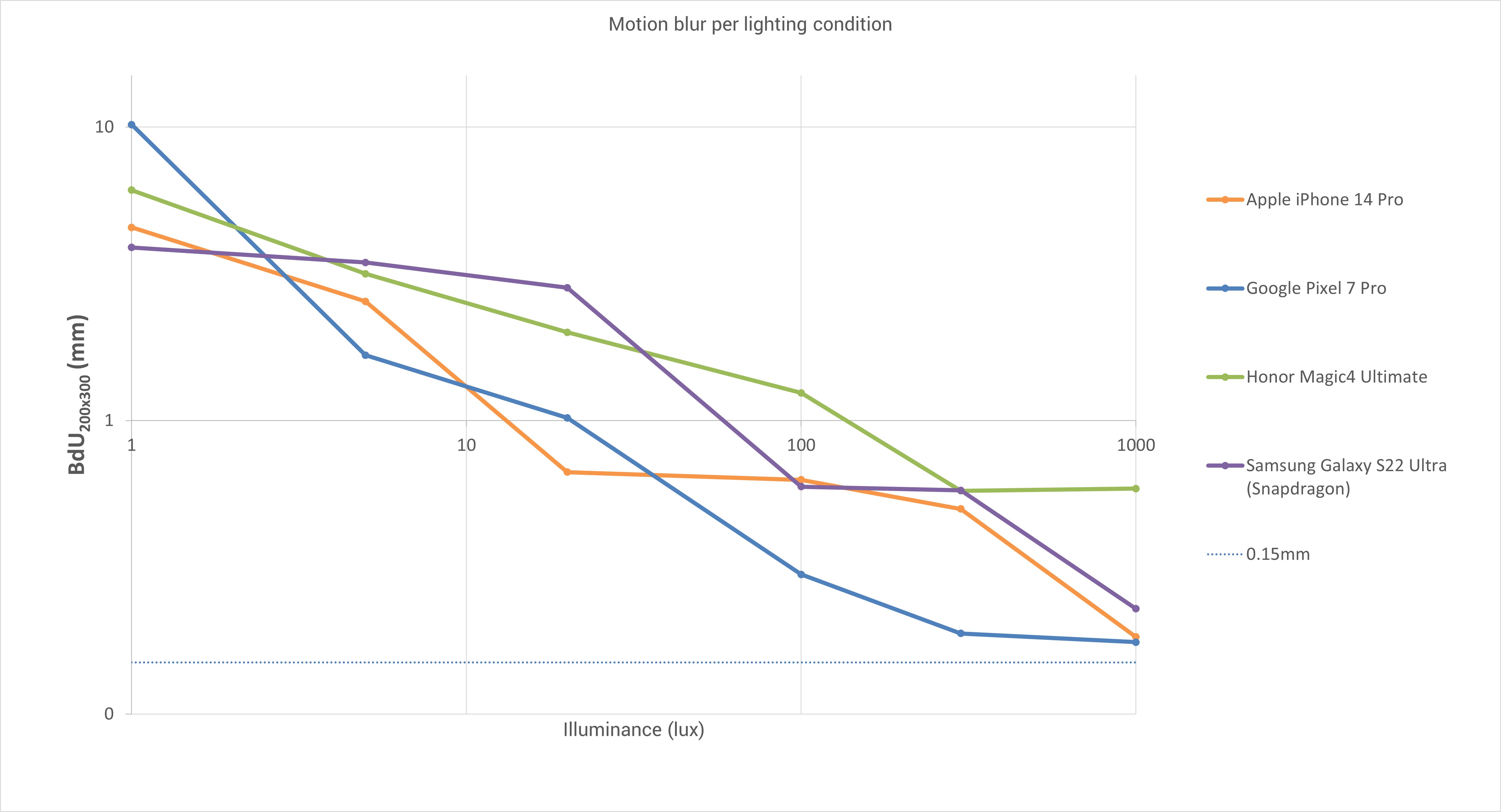

Noise
Google Pixel 7 Pro
115
Noise tests analyze various attributes of noise such as intensity, chromaticity, grain, structure on real-life images as well as images of charts taken in the lab. For natural images, particular attention is paid to the noise on faces, landscapes, but also on dark areas and high dynamic range conditions. Noise on moving objects is also evaluated on natural images. Objective measurements are performed on images of charts taken in various conditions from 1 to 1000 lux and different kinds of dynamic range conditions. The chart used is the Dead Leaves chart and the standardized measurement such as Visual Noise derived from ISO 15739.
Noise is one of the Pixel 7 Pro camera’s weaker points. Image is usually well under control in bright light and in normal indoor scenes, with only a little noise visible. However, under high-contrast conditions, strong coarse noise makes an appearance in the shadows, which can have an impact on the overall rendering of the image. The same happens in difficult low-light scenes. We also observed some inconsistency in terms of noise reduction. In a series of shots of the same scene noise reduction works better in some images than in others.

Artifacts
Google Pixel 7 Pro
81
The artifacts evaluation looks at lens shading, chromatic aberrations, geometrical distortion, edges ringing, halos, ghosting, quantization, unexpected color hue shifts, among others type of possible unnatural effects on photos. The more severe and the more frequent the artifact, the higher the point deduction on the score. The main artifacts observed and corresponding point loss are listed below.
Artifacts are usually very well under control on Google devices, and the Pixel 7 Pro is no exception. Fusion artifacts and hue shifts that we can see on many competitors are usually avoided, even in difficult HDR scenes. However, some slight aliasing can be visible, depending on the light conditions, on the content of the image.
Preview
Google Pixel 7 Pro
91
Preview tests analyze the image quality of the camera app's preview of the image, with particular attention paid to the difference between the capture and the preview, especially regarding dynamic range and the application of the bokeh effect. Also evaluated is the smoothness of the exposure, color and focus adaptation when zooming from the minimal to the maximal zoom factor available. The preview frame rate is measured using the LED Universal Timer.
The Google Pixel 7 Pro provides an accurate preview of HDR rendering, offering a good idea of the effect in the final capture. Motion of the preview is usually smooth, but a slight lag can be noticeable in difficult backlit situations.
However, in contrast to many other Ultra-Premium segment phones, the simulated bokeh effect is not visible in the preview image. You’ll have to capture an image and check it to find out what the effect has done to the scene.
Bokeh
Google Pixel 7 Pro
80
Bokeh is tested in one dedicated mode, usually portrait or aperture mode, and analyzed by visually inspecting all the images captured in the lab and in natural conditions. The goal is to reproduce portrait photography comparable to one taken with a DLSR and a wide aperture. The main image quality attributes paid attention to are depth estimation, artifacts, blur gradient, and the shape of the bokeh blur spotlights. Portrait image quality attributes (exposure, color, texture) are also taken into account.
The Pixel’s bokeh mode usually works well, with accurate subject segmentation and a nice blur gradient on foreground and background. However, some slight instabilities can be visible on spotlights in the background across a series of consecutive shots.
One of the reasons why the Google Pixel 7 Pro bokeh score is slightly below the best in class, such as the Honor Magic4 Ultimate, is the slightly short focal length used in bokeh simulation. At roughly 36mm, it is not ideal for portrait photography. To fill the frame with the subject, you have to get very close, which can induce distortion and other non-desired effects on faces.
Zoom
Google Pixel 7 Pro
151
DXOMARK engineers capture and evaluate over 400 test images in controlled lab environments and in outdoor, indoor, and low-light natural scenes, using the camera’s default settings and pinch zoom at various zoom factors from ultra wide to very long-range zoom. The evaluation is performed by visually inspecting the images against a reference of natural scenes, and by running objective measurements of chart mages captured in the lab under different conditions from 20 to 1000 lux and color temperatures from 2300K to 6500K.
Smartphone zoom technology is evolving across the industry, and the Pixel 7 Pro is no exception. The new model comes with some important improvements over the previous generation. A longer equivalent focal length improves image quality at long tele range, a image fusion is used to improve images captured at medium range. There are still some inconsistencies across a series of images but the camera often manages to capture detail at the center of the frame in tele shots.
At 13.5mm focal length equivalent, the ultra-wide has also been upgraded for a wider field of view. Ultra-wide shots feature a wide dynamic range and nice colors, with only a few distortion artifacts.

Wide
Google Pixel 7 Pro
117
These tests analyze the performance of the ultra-wide camera at several focal lengths from 12 mm to 20 mm. All image quality attributes are evaluated, with particular attention paid to such artifacts as chromatic aberrations, lens softness, and distortion. Pictures below are an extract of tested scenes.
The Pixel 7 Pro provides very decent ultra-wide image quality. Distortion is well under control and all other image qualities are well managed. The level of detail is not quite on the same level as the best in class, such as the Honor Magic4 Ultimate, but image results are nice in most cases nonetheless.

Tele
Google Pixel 7 Pro
116
All image quality attributes are evaluated at focal lengths from approximately 40 mm to 300 mm, with particular attention paid to texture and detail. The score is derived from a number of objective measurements in the lab and perceptual analysis of real-life images.
Tele zoom performance has greatly improved over the Pixel 6 Pro, especially at medium range. This is due to a new fusion algorithm that is capable of recovering detail at the center of the frame by using image information captured by the tele module. This information is then integrated into the image captured by the wider primary camera. This system is mainly used at close and medium range before the dedicated tele module takes fully over. This kind of system has been in use on devices from brands such as Huawei or Honor, but this is the first time we are seeing it on a Pixel.
Some instabilities can be noticeable, though, especially across a series of shots. At long range (120mm and longer), the device offers the same image quality that was already available on the Pixel 6 Pro, with nice and sharp images in most conditions.
Video
Google Pixel 7 Pro
149
DXOMARK engineers capture and evaluate more than 2.5 hours of video in controlled lab environments and in natural low-light, indoor and outdoor scenes, using the camera’s default settings. The evaluation consists of visually inspecting natural videos taken in various conditions and running objective measurements on videos of charts recorded in the lab under different conditions from 1 to 1000+ lux and color temperatures from 2,300K to 6,500K.
In terms of video performance, the Pixel lags slightly behind one of its main rivals, the Apple iPhone 14 Pro Max, but nonetheless offers an overall very good video experience. Exposure is usually well managed, with a wide dynamic range retaining good highlight and shadow detail. Colors are usually nice, despite some casts in difficult high-contrast scenes. Video autofocus has been perfected, accurately detecting the subject in the scene.
Detail is well preserved but, just like for still images, noise can become quite intrusive in high-contrast and low-light scenes. Overall, the device does very well for video and does best in bright outdoor conditions.

Exposure
Google Pixel 7 Pro
115
Exposure tests evaluate the brightness of the main subject and the dynamic range, eg. the ability to render visible details in both bright and dark areas of the image. Stability and temporal adaption of the exposure are also analyzed.
Video target exposure is accurate in most conditions, even in difficult low-light scenes. Like in photo mode, the camera opts for a slightly darker exposure than the iPhone, but faces, including dark skin tones in low light, are hardly ever underexposed.
Dynamic range in video is fairly wide, with smooth brightness transitions in bright sunlight.

Color
Google Pixel 7 Pro
117
Image-quality color analysis looks at color rendering, skin-tone rendering, white balance, color shading, stability of the white balance and its adaption when light is changing.
In bright outdoor conditions, colors are vivid and accurate, with an overall neutral white balance and accurate skin tones. However, when recording video indoors, the camera sometimes struggles to manage color transitions. As a result, our testers observed a very warm orange cast, especially in high-contrast conditions. In low-light, color rendering and white balance are accurate. In addition, skin tones are decent across all skin types.

Texture
Google Pixel 7 Pro
115
Texture tests analyze the level of details and texture of the real-life videos as well as the videos of charts recorded in the lab. Natural videos recordings are visually evaluated, with particular attention paid to the level of details in the bright and areas as well as in the dark. Objective measurements are performed of images of charts taken in various conditions from 1 to 1000 lux. The charts used are the DXOMARK chart (DMC) and Dead Leaves chart.
Pixel 7 Pro video footage shows good detail, especially in bright light. In low light, the level of detail is in line with the competition. Fine detail is lost, but overall the scene is nicely rendered in most conditions.

Noise
Google Pixel 7 Pro
118
Noise tests analyze various attributes of noise such as intensity, chromaticity, grain, structure, temporal aspects on real-life video recording as well as videos of charts taken in the lab. Natural videos are visually evaluated, with particular attention paid to the noise in the dark areas and high dynamic range conditions. Objective measurements are performed on the videos of charts recorded in various conditions from 1 to 1000 lux. The chart used is the DXOMARK visual noise chart.
Like in photo mode, our testers observed some strong coarse noise in HDR and low-light scenes. This is slightly more intrusive in video than for photo , mainly because of the temporal aspect of noise, with noise specs changing position in every video frame. This said, the Pixel still does better for noise than some strong competitors, including the Samsung Galaxy S22 Ultra (Snapdragon). However, it is outperformed by others with a more effective noise reduction strategy, like the Honor Magic4 Ultimate.

Stabilization
Google Pixel 7 Pro
117
Stabilization evaluation tests the ability of the device to stabilize footage thanks to software or hardware technologies such as OIS, EIS, or any others means. The evaluation looks at residual motion, smoothness, jello artifacts and residual motion blur on walk and run use cases in various lighting conditions. The video below is an extract from one of the tested scenes.
Video stabilization is effective, even in challenging running sequences. Only a small amount of camera motion and some frame shift is noticeable. In low light, sharpness differences between frames become pretty noticeable.

Artifacts
Google Pixel 7 Pro
86
Artifacts are evaluated with MTF and ringing measurements on the SFR chart in the lab as well as frame-rate measurements using the LED Universal Timer. Natural videos are visually evaluated by paying particular attention to artifacts such as aliasing, quantization, blocking, and hue shift, among others. The more severe and the more frequent the artifact, the higher the point deduction from the score. The main artifacts and corresponding point loss are listed below.
Like in photo mode, artifacts are overall well under control and rendering is consistent across all conditions.

 English
English 中文
中文

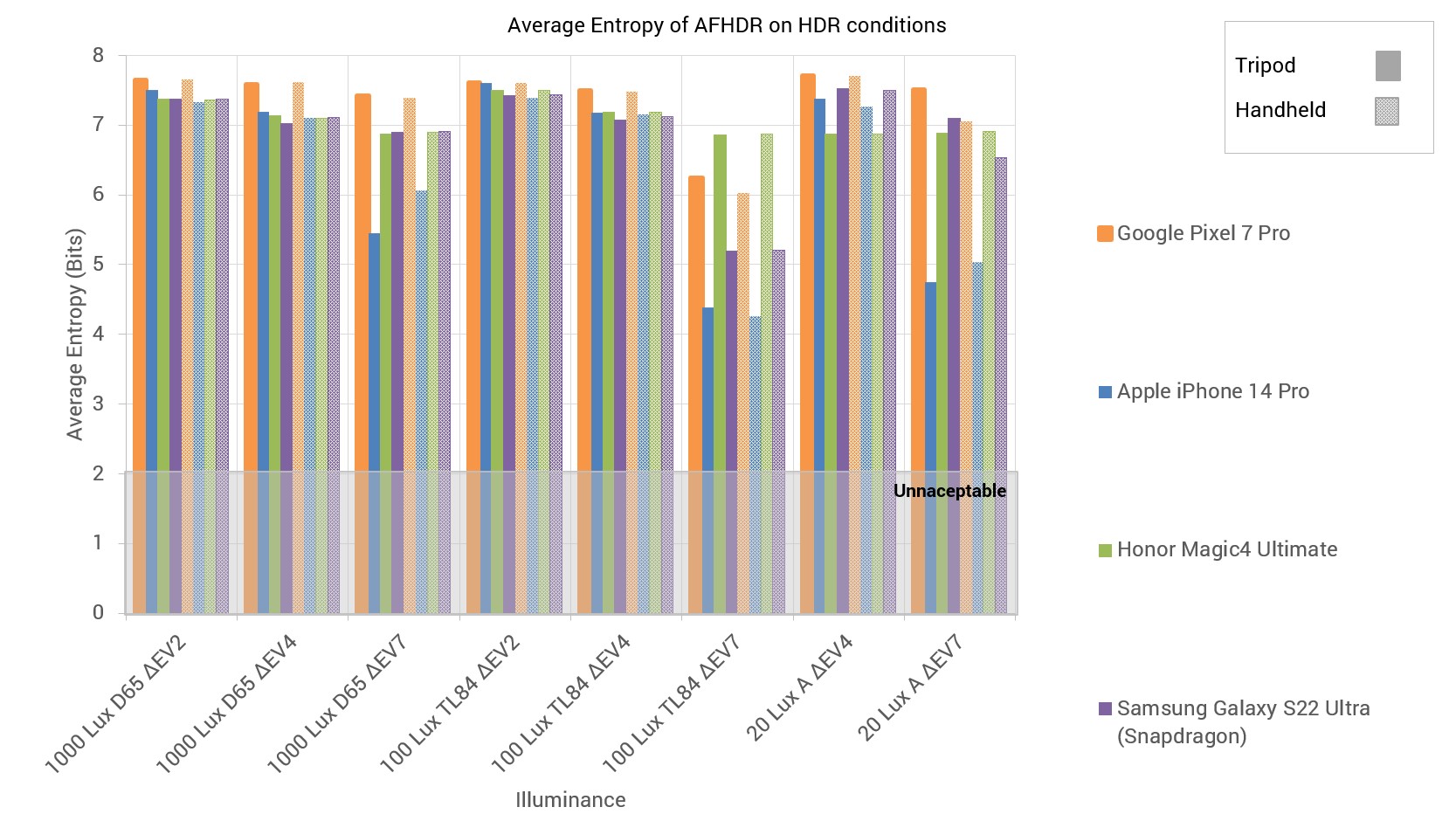





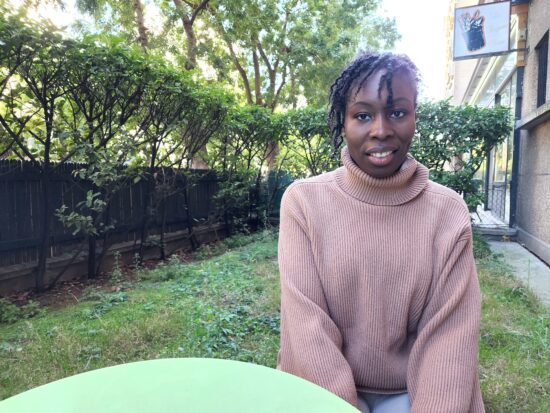
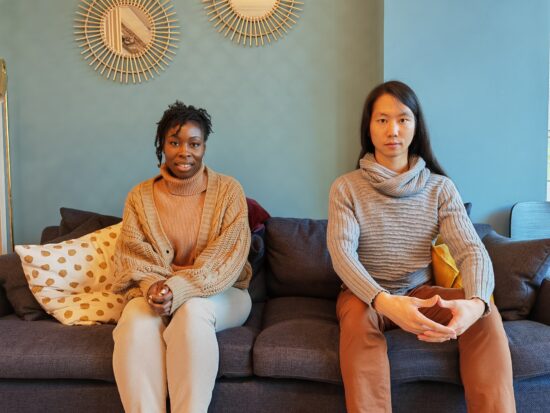


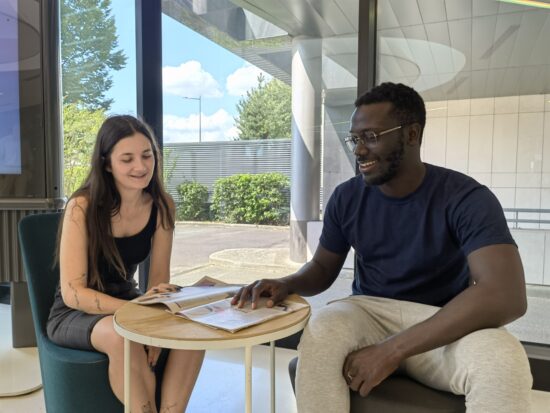




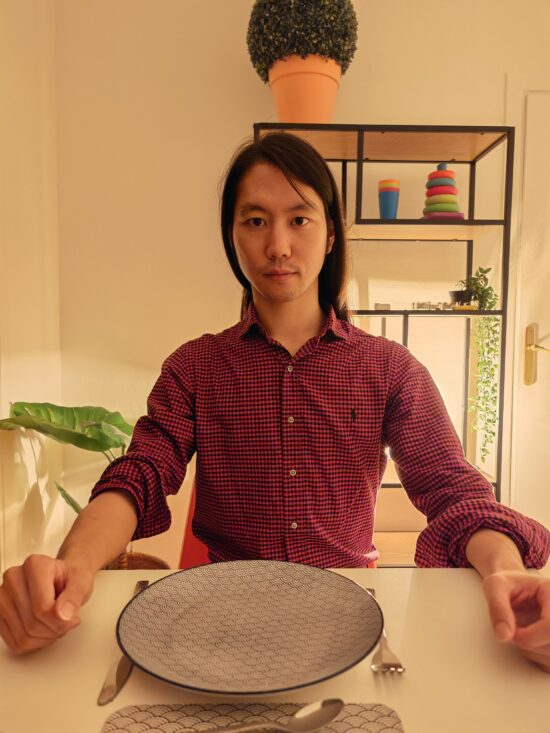


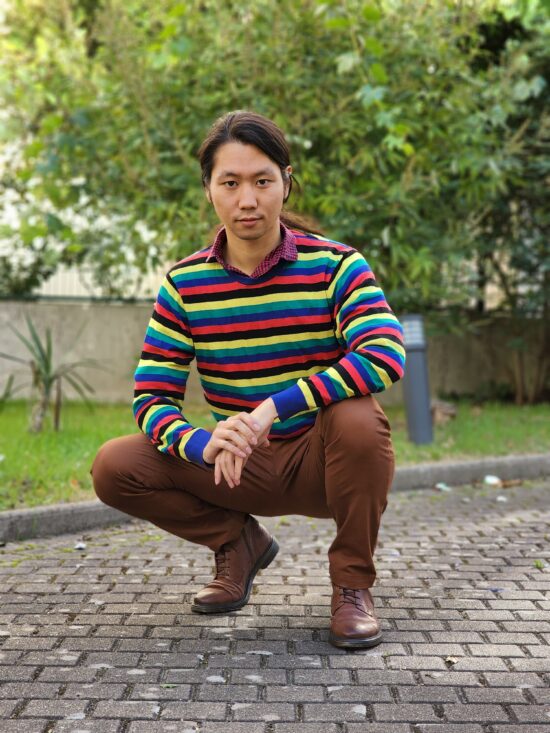
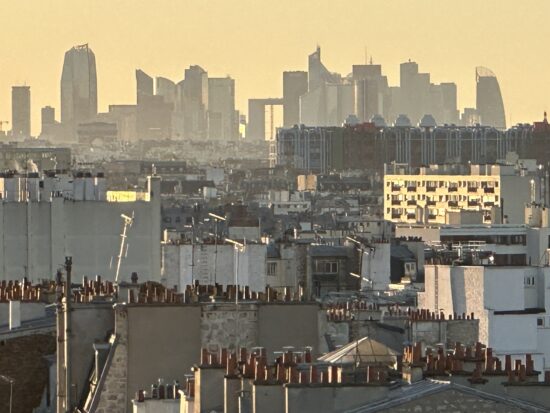
DXOMARK invites our readership (you) to post comments on the articles on this website. Read more about our Comment Policy.